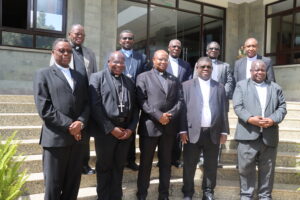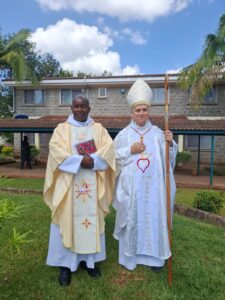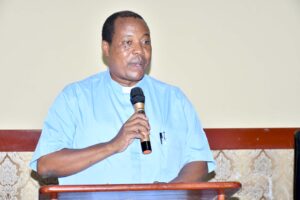TANZANIA: The Church in Tanzania to celebrate the climax of 150 years of evangelization in October, 2018.

Secretary of the Preparatory Committee for the Jubilee Fr. Dr. Faustine Kamugisha said that, the celebration will be held at Bagamoyo where the first Holy Ghost missionaries landed.
“It will be in October this year which is a month of missions, under the theme, “The 150 Jubilee of Evangelism: The Joy of the Gospel,” he said.
Speaking with AMECEA correspondent about the jubilee, Archbishop Emeritus of Arusha Most Rev Josaphat Lebulu said that, the Jubilee celebrations are held in Bagamoyo simply because it is the place of reflection of faith as it is an entry point of Christianity to the Eastern part of Africa and a source of hope for Tanzanians who were tortured as slaves before taken across the Indian ocean.
“We celebrate the great work done by Missionaries who came to Tanzania at Bagamoyo particular in 1868. They installed the Holy Cross, a Symbol of redemption from slavery, a symbol of faith to us,” he said.
Most Rev. Lebulu said Bagamoyo was a door of exporting Africans as slaves, a door of slave trade. The same door turned out to be the gateway of the Word of God, light, peace, hope and love and that was the beginning of the spread of Christianity in East Africa.
“Bagamoyo is a symbol of redemption, a place where man has received the opportunity to grow in faith and gain hope. Bagamoyo is a fountain of true freedom and a door of faith. It reflects the refusal of desperate people, a city of light,” he explained.
He said it is the time for the Catholic Church in Tanzania to sing praises to God and give thanks to the great work done by Missionaries who sacrificed themselves by focusing on extensive evangelization, which touched the fundamental human basic needs of education, health, well-being and integral human development.
He also explained that, Missionaries did not come as traders or investors, but stakeholders of human development both physically and spiritually, therefore, their services were more directed to people living in rural areas.
“These services were given to God’s family without discrimination. The church from the beginning of his mission has been in the forefront of ensuring that it continues the work for the redemption of the people: spiritual and physical; the work done by Christ Jesus: by removing people from their sins; by curing their illnesses and their physical problems and ultimately, providing them with their basic needs; He was touched by the anxiety of the people: spiritually and physically; he gave special privileges to the poor and all those who were being forced on the sidewalk of the community, since the poor are usually the target of the Gospel of Salvation,” he said.
The Archbishop Emeritus urged every Catholic to be true missionary, to preach by action and to be a true model of the Gospel.
The short history of Evangalization in Tanzania
Holy Ghost Fathers, who were under the leadership of Fr. Antoine Horner, arrived in Zanzibar in 1863. They received great opposition from Muslims and then crossed the sea to the mainland of Bagamoyo in 1868. Here they set up free villages of slaves.
In these villages they received and taught slaves freed from Arab traders and English ships to abolish the Slave trade. From Bagamoyo, with the help of catechists taught in the villages of free bonds, the missionaries traveled to the eastern part of Mount Kilimanjaro in Moshi.
The exiled slaves were the first catechists. These helped evangelize Zanzibar Provinces, Morogoro, Moshi, Tanga, Same, Kondoa, Arusha, Dodoma and parts Mbulu among others.
It was difficult for Bagamoyo people to accept the Gospel so the decision of Dutch-speaking missionaries was to move to Morogoro city. Bagamoyo was left for a long time without priesthood services (pastoral service) or Eucharistic celebrations.
This led to poor growth of Bagamoyo Church until 1992 when the first African Priest entered and settled in Bagamoyo permanently. The first African priest was Father Valentine Bayo of the Holy Spirit Missionaries. Since he settled in Bagamoyo, he has been able to give Bagamoyo status today. Some call him Bayo “Father of New Bagamoyo Evangelism.”
He developed Bagamoyo from one parish to three parishes, namely Holy Spirit, Epiphany and Christ the King. He also made it an area of humanitarian liberation, education, health and other social services.
To date, there are Marian schools (Marian boys/girls) one of the leading schools in Tanzania. Most of the people in Bagamoyo have gone through Marian technical schools to acquire technical and employment professionals in various fields including carpentry, sewing, masonry, crafts, paintings, catering, and hotel services.
Education has become the main way of introducing new Bagamoyo, since today there is Marian Bagamoyo’s University of Science in Science Education.
∽End∽
Sarah Pelaji, Kiongozi Newspaper TEC


